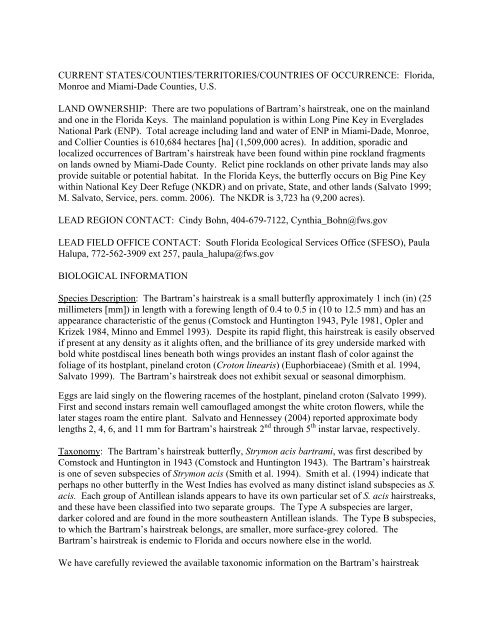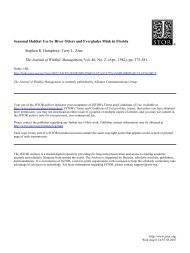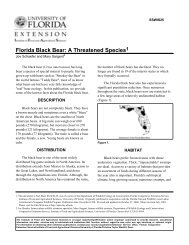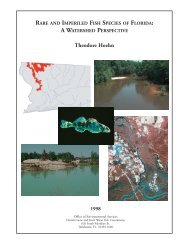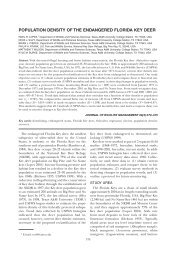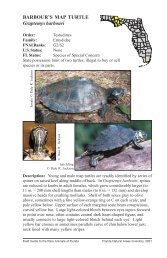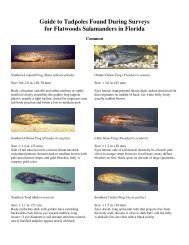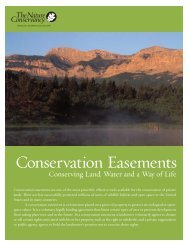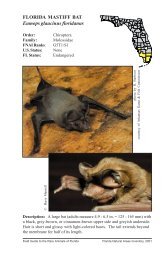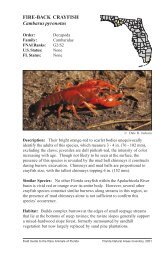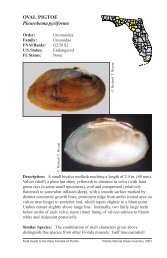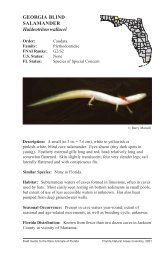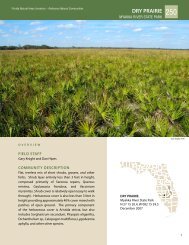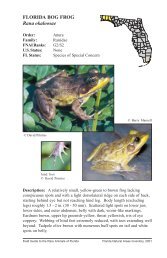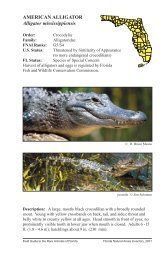Bartram's hairstreak butterfly - Florida Wildlife Conservation Guide
Bartram's hairstreak butterfly - Florida Wildlife Conservation Guide
Bartram's hairstreak butterfly - Florida Wildlife Conservation Guide
Create successful ePaper yourself
Turn your PDF publications into a flip-book with our unique Google optimized e-Paper software.
CURRENT STATES/COUNTIES/TERRITORIES/COUNTRIES OF OCCURRENCE: <strong>Florida</strong>,<br />
Monroe and Miami-Dade Counties, U.S.<br />
LAND OWNERSHIP: There are two populations of Bartram’s <strong>hairstreak</strong>, one on the mainland<br />
and one in the <strong>Florida</strong> Keys. The mainland population is within Long Pine Key in Everglades<br />
National Park (ENP). Total acreage including land and water of ENP in Miami-Dade, Monroe,<br />
and Collier Counties is 610,684 hectares [ha] (1,509,000 acres). In addition, sporadic and<br />
localized occurrences of Bartram’s <strong>hairstreak</strong> have been found within pine rockland fragments<br />
on lands owned by Miami-Dade County. Relict pine rocklands on other private lands may also<br />
provide suitable or potential habitat. In the <strong>Florida</strong> Keys, the <strong>butterfly</strong> occurs on Big Pine Key<br />
within National Key Deer Refuge (NKDR) and on private, State, and other lands (Salvato 1999;<br />
M. Salvato, Service, pers. comm. 2006). The NKDR is 3,723 ha (9,200 acres).<br />
LEAD REGION CONTACT: Cindy Bohn, 404-679-7122, Cynthia_Bohn@fws.gov<br />
LEAD FIELD OFFICE CONTACT: South <strong>Florida</strong> Ecological Services Office (SFESO), Paula<br />
Halupa, 772-562-3909 ext 257, paula_halupa@fws.gov<br />
BIOLOGICAL INFORMATION<br />
Species Description: The Bartram’s <strong>hairstreak</strong> is a small <strong>butterfly</strong> approximately 1 inch (in) (25<br />
millimeters [mm]) in length with a forewing length of 0.4 to 0.5 in (10 to 12.5 mm) and has an<br />
appearance characteristic of the genus (Comstock and Huntington 1943, Pyle 1981, Opler and<br />
Krizek 1984, Minno and Emmel 1993). Despite its rapid flight, this <strong>hairstreak</strong> is easily observed<br />
if present at any density as it alights often, and the brilliance of its grey underside marked with<br />
bold white postdiscal lines beneath both wings provides an instant flash of color against the<br />
foliage of its hostplant, pineland croton (Croton linearis) (Euphorbiaceae) (Smith et al. 1994,<br />
Salvato 1999). The Bartram’s <strong>hairstreak</strong> does not exhibit sexual or seasonal dimorphism.<br />
Eggs are laid singly on the flowering racemes of the hostplant, pineland croton (Salvato 1999).<br />
First and second instars remain well camouflaged amongst the white croton flowers, while the<br />
later stages roam the entire plant. Salvato and Hennessey (2004) reported approximate body<br />
lengths 2, 4, 6, and 11 mm for Bartram’s <strong>hairstreak</strong> 2 nd through 5 th instar larvae, respectively.<br />
Taxonomy: The Bartram’s <strong>hairstreak</strong> <strong>butterfly</strong>, Strymon acis bartrami, was first described by<br />
Comstock and Huntington in 1943 (Comstock and Huntington 1943). The Bartram’s <strong>hairstreak</strong><br />
is one of seven subspecies of Strymon acis (Smith et al. 1994). Smith et al. (1994) indicate that<br />
perhaps no other <strong>butterfly</strong> in the West Indies has evolved as many distinct island subspecies as S.<br />
acis. Each group of Antillean islands appears to have its own particular set of S. acis <strong>hairstreak</strong>s,<br />
and these have been classified into two separate groups. The Type A subspecies are larger,<br />
darker colored and are found in the more southeastern Antillean islands. The Type B subspecies,<br />
to which the Bartram’s <strong>hairstreak</strong> belongs, are smaller, more surface-grey colored. The<br />
Bartram’s <strong>hairstreak</strong> is endemic to <strong>Florida</strong> and occurs nowhere else in the world.<br />
We have carefully reviewed the available taxonomic information on the Bartram’s <strong>hairstreak</strong>


